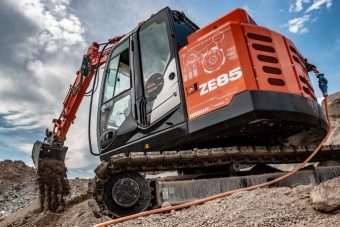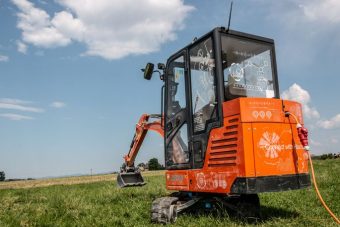
Even in cities like Oslo, Norway, which is typically thought of as progressive and “green”, more than 20% of the total CO2 emissions comes from heavy-duty construction equipment. That’s a huge number, and you can bet that older, less regulated machines in other major cities are even worse. That fact has motivated the authorities in Oslo to enact laws that say all new, public buildings must be built with “fossil-free” construction machinery. The jobsite you see here, featuring a ZE85 battery-powered electric excavator from Suncar HK, is just such a fossil-free site. What’s more, it’s believed to be the first zero emission, all-electric jobsite of its kind.
Norway’s new laws banning heavy polluters like diesel construction machines and even passenger cars from certain city centers are hardly unique. Cities like Barcelona, London, and Beijing have already passed similar laws that will go into effect in the coming years, and it’s hard to believe other countries won’t get in on the act soon, with the general public having seen how good things can get, and how quickly.
Those laws also explain why so many heavy equipment companies — including Liebherr, CASE, and Volvo CE — are spending heavily on R&D to electrify their lineup.
You can see the Suncar ZE85 battery-powered excavators get to work in this surprisingly quiet video, below, and check out the official Suncar press release below that.
Fast charging on the construction site: Swiss BEV excavator on a zero-emission construction site in Oslo
The ZE85 battery-powered electric excavator, which was presented last May at the world’s largest construction trade fair, bauma19 in Munich, is now being successfully operated on a zero-emission construction site in Norway. It is the first electric excavator with an integrated CCS fast-charging interface as it is known from electric cars. This enables full charging in under an hour.

Here is an enormous potential to reduce emissions on construction sites. In Oslo, for example, around 21% of CO2 emissions are emitted by construction machinery. Therefore, the authorities in Oslo have defined in their procurement strategy that all public buildings must be built with “fossil-free” construction machinery. The European Commission is also setting the trend, issuing guidelines in the areas of “Buying green” and “Green Public Procurement” and regulating emissions on construction sites. As a result, clean technologies such as battery-powered construction machinery are also finding their way into the construction industry.
In order to be able to tap into this rapidly growing market, more and more construction machinery manufacturers are electrifying their machines. At the R&D site of the Zurich-based start-up company SUNCARHK AG, excavators and other construction machines are electrified on behalf of major manufacturers such as Hitachi, Liebherr and others. The battery-powered vehicles and machines are successfully in use throughout Europe. The ZE85 electric excavator, developed together with SUNCAR, is in operation in Oslo on a zero-emission construction site, i.e. a construction site where only electrically driven construction machines are used. New and special to the battery-powered ZE85 excavator is the CCS fast charging interface, which is already standard on electric cars.
The electric excavators can be operated both in battery and cable mode. They have an onboard charger and can be charged at a worksite distribution board via a standard CEE three-phase power socket. The ZE85 excavator used in Oslo has a DC charging connection which reduces the charging time to three quarters of an hour.
With the vehicle-side modular DC charging system INTERFLOW, developed by SUNCAR, such a DC fast charging interface can be integrated into a vehicle or machine with little effort. The system enables the DC fast charging of high-voltage batteries up to 280 kW according to the CCS (Combined Charging System) protocol known from electric vehicles. This system can be integrated into any other battery-powered vehicle or machine with a system voltage of up to 800 VDC and a maximum charging current of 350 A and can be combined with an on-board charger.
Author: Jo Borrás
Source: Clean Technica, Suncar HK



